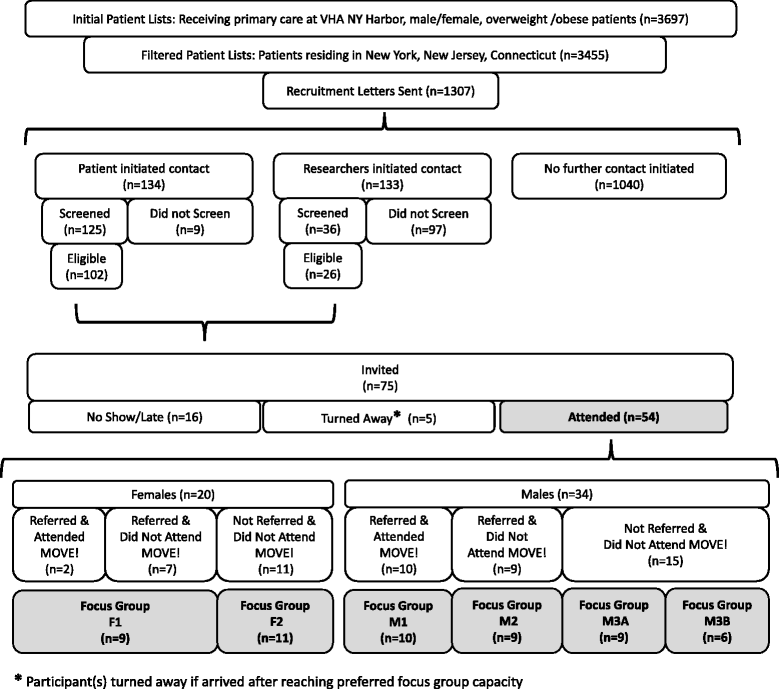Military service and other socioecological factors influencing weight and health behavior change in overweight and obese Veterans: a qualitative study to inform intervention development within primary care at the United States Veterans Health Administration
- PMID: 26855786
- PMCID: PMC4736653
- DOI: 10.1186/s40608-016-0087-3
Military service and other socioecological factors influencing weight and health behavior change in overweight and obese Veterans: a qualitative study to inform intervention development within primary care at the United States Veterans Health Administration
Abstract
Background: Obesity affects 37 % of patients at Veterans Health Administration (VHA) medical centers. The VHA offers an intensive weight management program (MOVE!) but less than 10 % of eligible patients ever attend. However, VHA patients see their primary care provider about 3.6 times per year, supporting the development of primary care-based weight management interventions. To address gaps in the literature regarding Veterans' experiences with weight management and determine whether and how to develop a primary care-based weight management intervention to both improve obesity counseling and increase attendance to MOVE!, we conducted a qualitative study to assess: 1) Veterans' personal experiences with healthy weight-related behavior change (including barriers and facilitators to behavior change and experiences with primary care providers, staff, and the MOVE! program), and 2) potential new approaches to improve weight management within primary care at the VHA including goal setting and technology.
Methods: Overweight/obese VHA patients (aged 18-75, BMI greater than 30 or greater than 25 with at least 1 co-morbidity) were recruited for focus group sessions stratified by gender, MOVE! referral, and attendance. Each session was facilitated by a trained moderator, audio-recorded, and professionally transcribed. Using an iterative coding approach, two coders separately reviewed and coded transcripts, and met frequently to negotiate codes and synthesize emerging themes.
Results: Of 161 eligible patients, 54 attended one of 6 focus groups (2 female, 4 male, 9-11 participants per session): 63 % were male, 46 % identified as African-American, 32 % White/Caucasian, 74 % were college-educated or higher, and 61 % reported having attended MOVE!. We identified two major themes: Impact of Military Service and Promotion and Sustainability of Healthy Behaviors. After service in a highly structured military environment, Veterans had difficulty maintaining weight on their own. They perceived physical activity as having more impact than diet, but chronic pain was a barrier. We identified individual/interpersonal-, community/environment-, and healthcare system-related factors affecting healthy behaviors. We also received input about Veteran's preferences and experiences with technology and setting health goals.
Conclusions: Unique factors influence weight management in Veterans. Findings will inform development of a technology-assisted weight management intervention with tailored counseling and goal-setting within primary care at the VHA.
Keywords: Focus groups; Obesity; Primary care; Qualitative; Veterans; Weight management.
Figures
Similar articles
-
Barriers and facilitators to providing primary care-based weight management services in a patient centered medical home for Veterans: a qualitative study.BMC Fam Pract. 2015 Nov 14;16:167. doi: 10.1186/s12875-015-0383-x. BMC Fam Pract. 2015. PMID: 26572125 Free PMC article.
-
Development of a 5As-based technology-assisted weight management intervention for veterans in primary care.BMC Health Serv Res. 2018 Jan 29;18(1):47. doi: 10.1186/s12913-018-2834-2. BMC Health Serv Res. 2018. PMID: 29378584 Free PMC article.
-
VA Outreach Is an Essential Area for Improving Veterans' Health Care Accessibility.Mil Med. 2023 Jul 22;188(7-8):e2439-e2447. doi: 10.1093/milmed/usad019. Mil Med. 2023. PMID: 36790439
-
Intensity and duration of obesity-related counseling: association with 5-Year BMI trends among obese primary care patients.Obesity (Silver Spring). 2012 Apr;20(4):773-82. doi: 10.1038/oby.2011.335. Epub 2011 Dec 1. Obesity (Silver Spring). 2012. PMID: 22134198 Review.
-
Rehabilitation Service Needs and Preferences among Veterans with Tinnitus: A Qualitative Study.Semin Hear. 2023 Jun 22;45(1):29-39. doi: 10.1055/s-0043-1770138. eCollection 2024 Feb. Semin Hear. 2023. PMID: 38370519 Free PMC article. Review.
Cited by
-
Dietary Quality and Perceived Barriers to Weight Loss among Older Overweight Veterans with Dysmobility.Int J Environ Res Public Health. 2022 Jul 27;19(15):9153. doi: 10.3390/ijerph19159153. Int J Environ Res Public Health. 2022. PMID: 35954511 Free PMC article.
-
A technology-assisted health coaching intervention vs. enhanced usual care for Primary Care-Based Obesity Treatment: a randomized controlled trial.BMC Obes. 2019 Feb 4;6:4. doi: 10.1186/s40608-018-0226-0. eCollection 2019. BMC Obes. 2019. PMID: 30766686 Free PMC article.
-
Peer-Assisted Lifestyle (PAL) intervention: a protocol of a cluster-randomised controlled trial of a health-coaching intervention delivered by veteran peers to improve obesity treatment in primary care.BMJ Open. 2021 Feb 26;11(2):e043013. doi: 10.1136/bmjopen-2020-043013. BMJ Open. 2021. PMID: 33637544 Free PMC article.
-
Exploring Health Outcomes for U.S. Veterans Compared to Non-Veterans from 2003 to 2019.Healthcare (Basel). 2021 May 18;9(5):604. doi: 10.3390/healthcare9050604. Healthcare (Basel). 2021. PMID: 34070037 Free PMC article.
-
Behavioral Treatment for Veterans with Obesity: 24-Month Weight Outcomes from the ASPIRE-VA Small Changes Randomized Trial.J Gen Intern Med. 2017 Apr;32(Suppl 1):40-47. doi: 10.1007/s11606-017-3987-0. J Gen Intern Med. 2017. PMID: 28271430 Free PMC article. Clinical Trial.
References
-
- NHLBI Obesity Education Initiative Expert Panel on the Identification, Evaluation, and Treatment of Obesity in Adults (US). Clinical Guidelines on the Identification, Evaluation, and Treatment of Overweight and Obesity in Adults: The Evidence Report. Bethesda, MD: National Heart, Lung, and Blood Institute; 1998.
Grants and funding
LinkOut - more resources
Full Text Sources
Other Literature Sources
Medical
Miscellaneous


